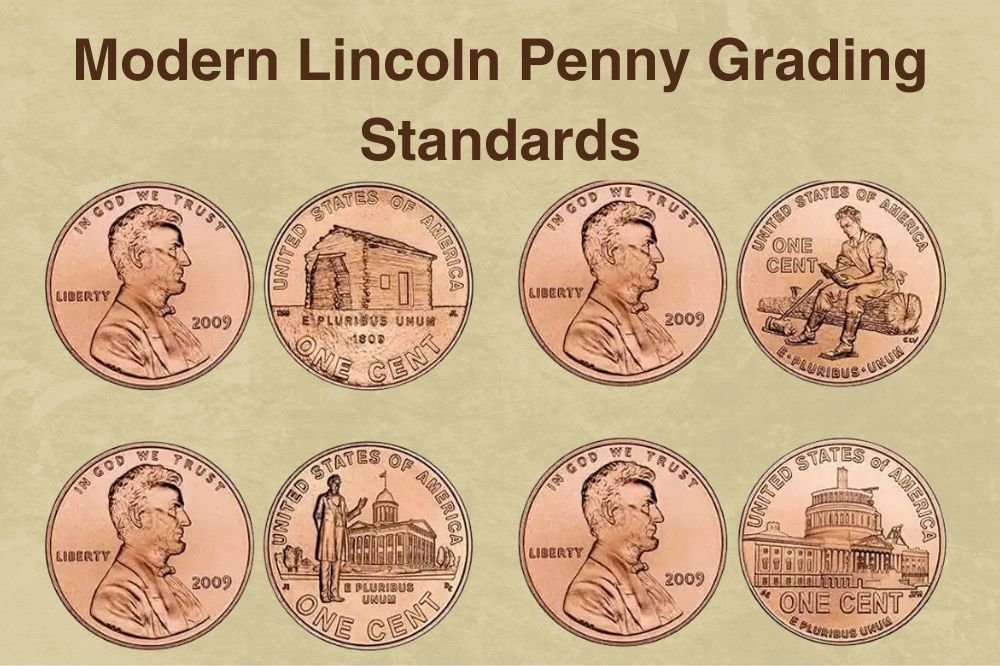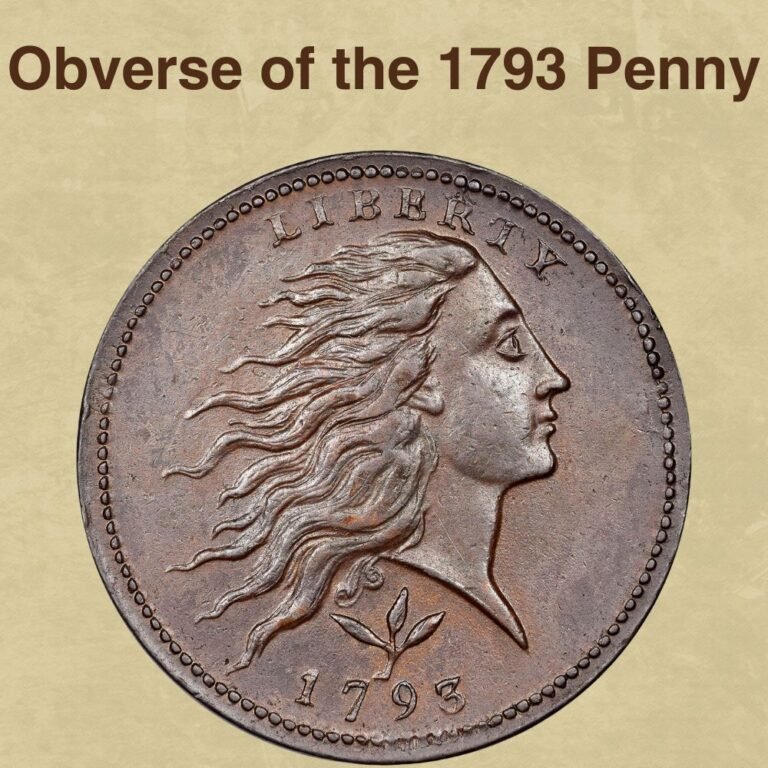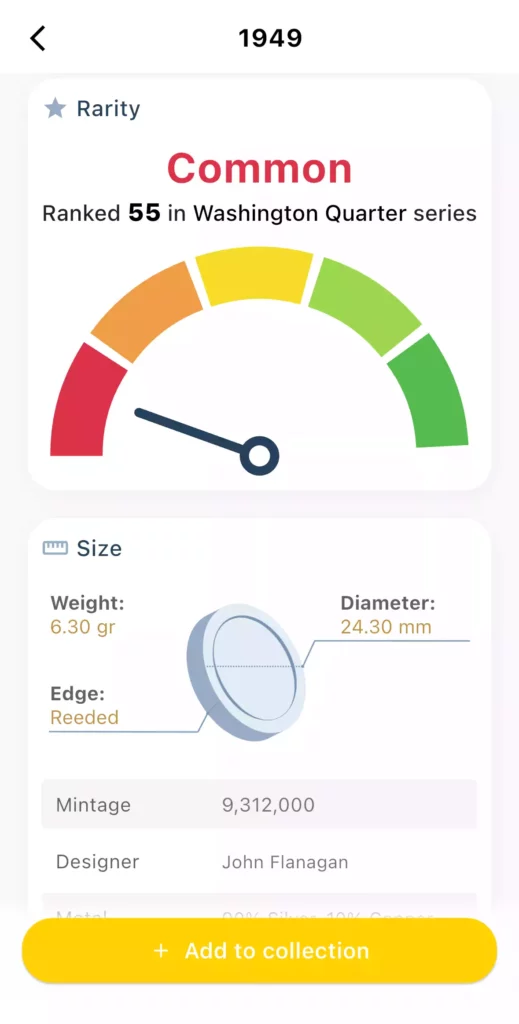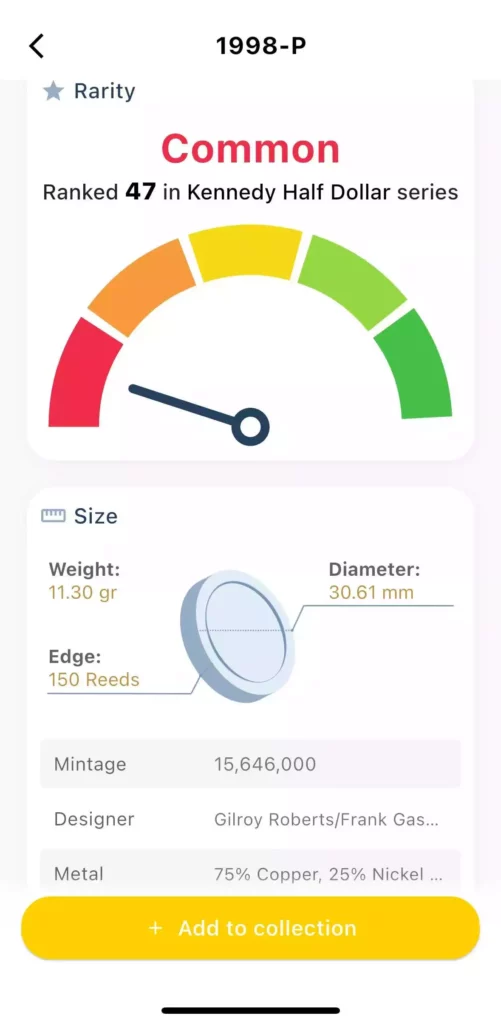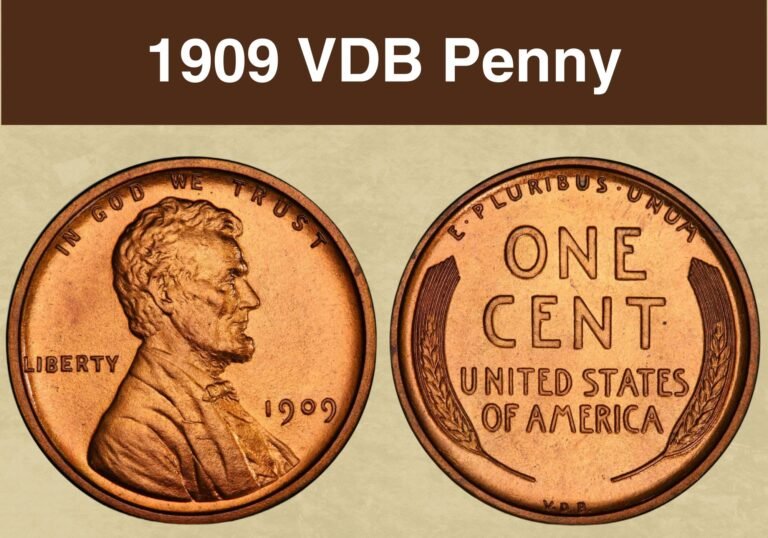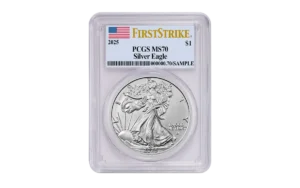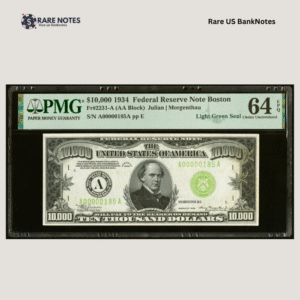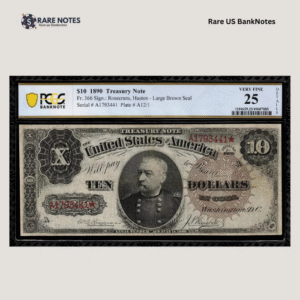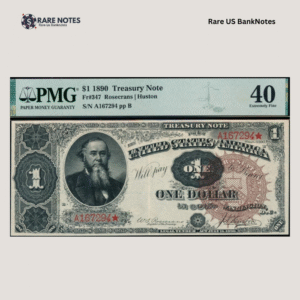The Lincoln penny has been an American icon for over a century, and modern Lincoln cents continue to captivate collectors worldwide. Whether you’re examining Memorial cents from your pocket change, hunting for pristine Shield pennies, or cherishing the special 2009 Bicentennial designs, understanding how to grade these coins properly is essential for any collector.
Since 1959, the Lincoln cent has undergone three major design changes, each bringing unique characteristics that affect grading. This guide will walk you through the process of evaluating modern Lincoln pennies, helping you determine their condition and value with confidence.
History of Modern Lincoln Pennies
The modern era of Lincoln cents began in 1959 when the familiar wheat ears reverse gave way to the Lincoln Memorial design. This marked the 150th anniversary of Lincoln’s birth and the 50th anniversary of the Lincoln cent itself.
Three distinct periods define modern Lincoln pennies:
- Memorial Cents (1959-2008): Featured the Lincoln Memorial on the reverse
- Bicentennial Cents (2009): Four special reverses celebrating Lincoln’s life
- Shield Cents (2010-present): Display the Union Shield, symbolizing Lincoln’s preservation of the United States
Modern Lincoln Penny Grading Standards

Before diving into specific grades, it’s important to understand that coin grading combines both art and science. While the Sheldon Scale provides a numerical framework from 1 to 70, assigning grades requires careful observation and experience.
Professional grading services like PCGS (Professional Coin Grading Service) and NGC (Numismatic Guaranty Corporation) employ teams of experts who evaluate thousands of coins daily. However, learning to grade coins yourself not only saves money but also sharpens your eye as a collector.
Essential Grading Tools
To grade Lincoln pennies effectively, you’ll need:
- A 5x to 10x magnifying loupe or jeweler’s loop
- Good lighting (preferably incandescent or LED)
- A soft surface to handle coins
- Reference guides with photographic examples
- Clean cotton gloves to avoid fingerprints
Modern Lincoln Penny Specifications
Understanding the physical characteristics of each design type helps in accurate grading:
Memorial Penny (1959-2008)
- Composition: 95% copper, 5% tin and zinc (1959-1982); 97.5% zinc, 2.5% copper plating (1982-2008)
- Weight: 3.11 grams (copper); 2.5 grams (zinc)
- Diameter: 19.05 mm
- Thickness: 1.52 mm
Bicentennial Penny (2009)
- Composition: 97.5% zinc, 2.5% copper plating
- Weight: 2.5 grams
- Four Reverse Designs: Birth and Early Childhood, Formative Years, Professional Life, Presidency
Shield Penny (2010-present)
- Composition: 97.5% zinc, 2.5% copper plating
- Weight: 2.5 grams
- Design Feature: Union Shield with 13 vertical stripes
Special Considerations for Modern Pennies
Color Designations
Like their Wheat penny predecessors, modern Lincoln cents receive color designations:
- RD (Red): Full original mint luster, most desirable
- RB (Red-Brown): Partial red luster mixed with brown toning
- BN (Brown): Predominantly brown, least valuable for same grade
Zinc Rot and Corrosion
Post-1982 zinc pennies present unique challenges. The thin copper plating can be breached, allowing moisture to corrode the zinc core. This “zinc rot” appears as white, powdery spots or bubbling under the surface. Unfortunately, this damage is irreversible and significantly impacts value.
How to Modern Lincoln Penny
Let’s examine each grade level, from the most worn to pristine mint state examples. Remember, grading requires examining both the obverse (front) and reverse (back) of the coin.
1. Poor (P-1)
These coins are barely identifiable as Lincoln cents. The date might be partially visible, but most design elements have worn smooth.
Obverse: Lincoln’s silhouette is faintly visible. The rim merges with the field in many areas. Date and lettering are mostly gone.
Reverse: Design type (Memorial, Shield, etc.) is barely recognizable. Most details are completely worn away.
2. Fair (FR-2)
Slightly better than Poor, but still heavily worn. The coin type is identifiable, though details remain minimal.
Obverse: Lincoln’s outline is clear, but facial features are gone. Some letters might be partially visible. The date, though worn, can usually be determined.
Reverse: The basic design shape is visible, but fine details are absent. On Memorial cents, you might see the building’s outline; on Shield cents, just the shield’s basic form.
3. About Good (AG-3)
These pennies show heavy wear but retain more recognizable features than lower grades.
Obverse: Lincoln’s head is outlined but flat. Most of the lettering is readable though weak. The date is fully visible but may blend with the rim.
Reverse:
- Memorial: Building outline is complete but lacks interior details
- Shield: Basic shield design visible but stripes merge together
- Lettering is mostly readable but weak
4. Good (G-4, G-6)
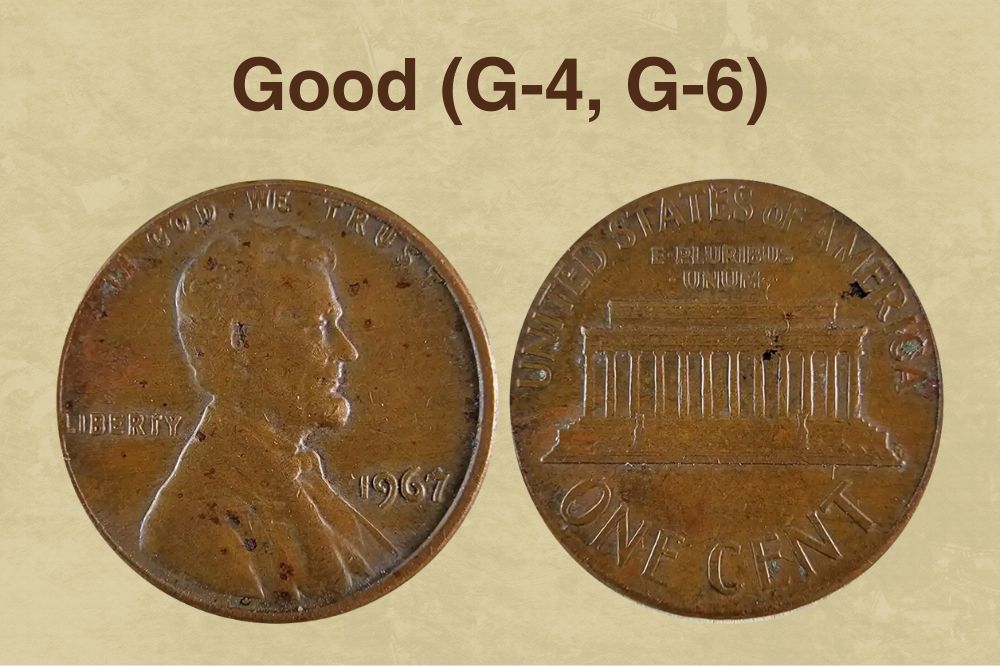
Coins in Good condition show significant wear but maintain the main design elements.
Obverse: Lincoln’s portrait is well-worn but complete. Hair above the ear is flat, and facial features merge. Letters and date are clear but may show weakness.
Reverse:
- Memorial: Columns are visible but worn, steps might be faintly outlined
- Shield: Individual stripes begin to show separation
- All lettering is complete and readable
5. Very Good (VG-8, VG-10)

Major design elements are clear despite moderate to heavy wear.
Obverse: Hair details begin to show, particularly at the back of Lincoln’s head. The bow tie is visible. Ear shows basic outline. Letters are bold and clear.
Reverse:
- Memorial: Some column details visible, steps show separation
- Shield: Most stripes are distinct, though worn at high points
- E PLURIBUS UNUM may show slight weakness
6. Fine (F-12, F-15)
Moderate, even wear characterizes Fine grade pennies.
Obverse: About half of Lincoln’s hair details are visible. The ear shows interior detail. Bow tie is complete. Cheek and jaw remain smooth but well-defined.
Reverse:
- Memorial: All columns show some detail, most steps are separated
- Shield: All 13 stripes are distinct with visible horizontal lines
- All lettering is sharp and clear
7. Very Fine (VF-20, VF-25, VF-30, VF-35)

Light to moderate wear appears only on the highest points.
Obverse: Most hair details are sharp, including strands above the ear. Fine lines in the bow tie are visible. The ear shows clear inner and outer detail.
Reverse:
- Memorial: Column details are sharp, individual steps clearly separated
- Shield: Horizontal lines within stripes are clear, scroll ends show detail
- Minor wear on highest points only
8. Extremely Fine (EF-40, EF-45)
Very light wear limited to the highest design points.
Obverse: All hair details are sharp and clear. Only slight wear shows on Lincoln’s cheek and jaw. The coat shows texture and buttons are detailed.
Reverse:
- Memorial: Slight wear on column tops and center steps only
- Shield: Light wear on top horizontal lines of shield
- Nearly full mint luster may remain in protected areas
9. About Uncirculated (AU-50, AU-53, AU-55, AU-58)

Trace wear visible only under magnification, with substantial mint luster remaining.
Obverse: Faint wear on cheek, jaw, and hair above ear. All details remain sharp. Luster is present but may be broken on high points.
Reverse:
- Memorial: Trace wear on building’s highest points
- Shield: Slight wear on top scroll and upper shield lines only
- AU-58 shows virtually full luster with minimal wear traces
10. Mint State (MS-60 to MS-70)

Uncirculated coins with no wear, graded by strike quality, luster, and eye appeal.
MS-60 to MS-63: May have numerous contact marks, spots, or weak strike areas. Luster may be impaired but coin shows no circulation wear.
MS-64 to MS-66: Fewer marks, better strike, and attractive luster. MS-65 is considered “gem” quality with strong eye appeal.
MS-67 to MS-70: Superior quality with minimal to no visible flaws. MS-70 is perfection – extremely rare for business strikes.
Design-Specific Grading Points
Memorial Reverse Focus Areas
- Columns: Check for definition in the fluting
- Steps: Count visible lines between columns
- Roof: Look for triangular detail sharpness
Shield Reverse Focus Areas
- Horizontal lines: Should be distinct within each stripe
- Scroll: Check ends for complete detail
- E PLURIBUS UNUM: Should be sharp and raised
Common Grading Challenges
Weak Strike vs. Wear
Some pennies, particularly from certain years and mints, show weak strikes that can be mistaken for wear. A weakly struck MS-65 might show less detail than a well-struck EF-45. Look for mint luster and contact marks rather than relying solely on detail.
Cleaned Coins
Harsh cleaning leaves pennies with an unnatural appearance – too bright, with hairlines or a “stripped” look. These are considered damaged and trade at significant discounts.
Environmental Damage
Besides zinc rot on modern cents, watch for:
- Corrosion spots (green or black)
- PVC damage from improper storage
- Fingerprints etched into the surface
Market Values and Grade Importance
While common date modern pennies in circulated grades hold minimal premium, certain dates and varieties command significant prices in high grades:
- 1969-S Doubled Die Obverse
- 1972 Doubled Die Obverse
- 1983 Doubled Die Reverse
- 1984 Doubled Ear
- 1992-D Close AM
- 1995 Doubled Die Obverse
In MS-67 or higher, even common dates can be valuable due to the difficulty in finding pristine examples.
Building Your Grading Skills
Becoming proficient at grading takes practice and patience. Here are some tips:
- Start with circulated coins: They’re cheaper and easier to distinguish between grades
- Compare with certified examples: Study slabbed coins at coin shows
- Use multiple sources: Different lighting angles reveal different details
- Join a coin club: Learn from experienced collectors
- Practice consistently: Grade the same coin multiple times over weeks
When to Use Professional Grading
Consider professional grading for:
- Key dates and varieties
- Coins you believe grade MS-65 or higher
- Any coin worth over $100
- Coins you plan to sell
Summary
Grading modern Lincoln pennies requires understanding the nuances of each design type, recognizing how wear patterns develop, and distinguishing between various surface conditions. While the Sheldon Scale provides a framework, remember that grading is subjective – two experts might disagree by a point or two.
Start with inexpensive examples and gradually work your way up to better coins. With practice, you’ll develop the confidence to accurately assess condition and make informed decisions about your collection. Whether you’re searching rolls for varieties or building a high-grade set, understanding grading fundamentals enhances both your enjoyment and success in the hobby.
Remember, every expert was once a beginner. Take your time, ask questions, and most importantly, have fun exploring the fascinating world of modern Lincoln cent collecting!
The post How to Grade Modern Lincoln Penny (1959-Date)? appeared first on CoinValueChecker.


